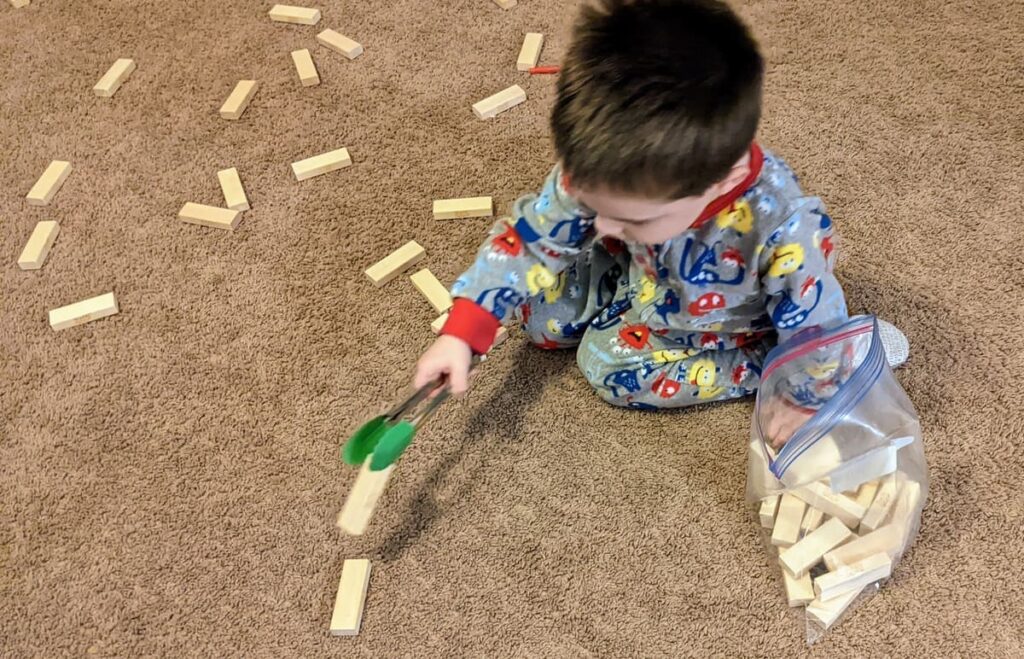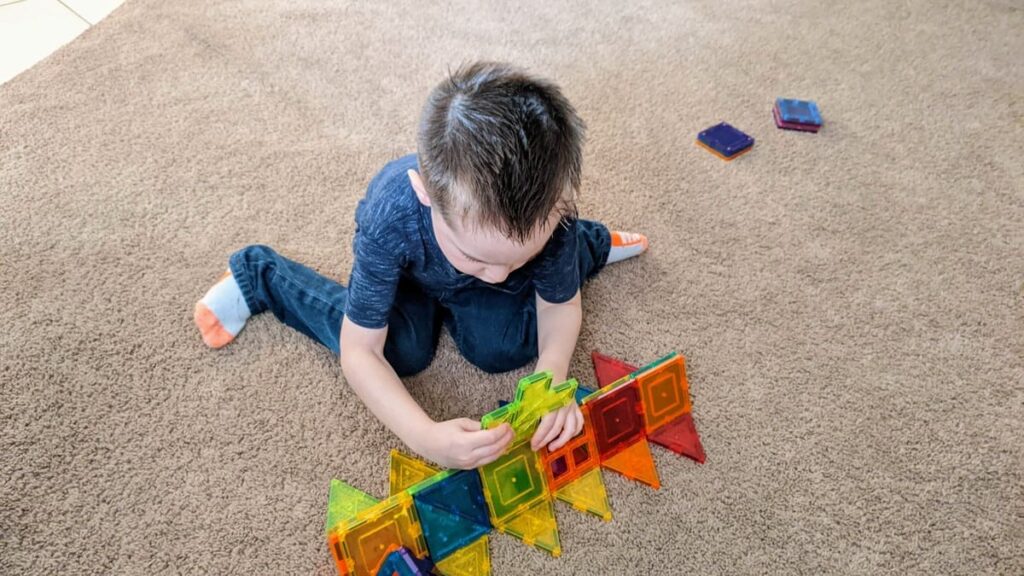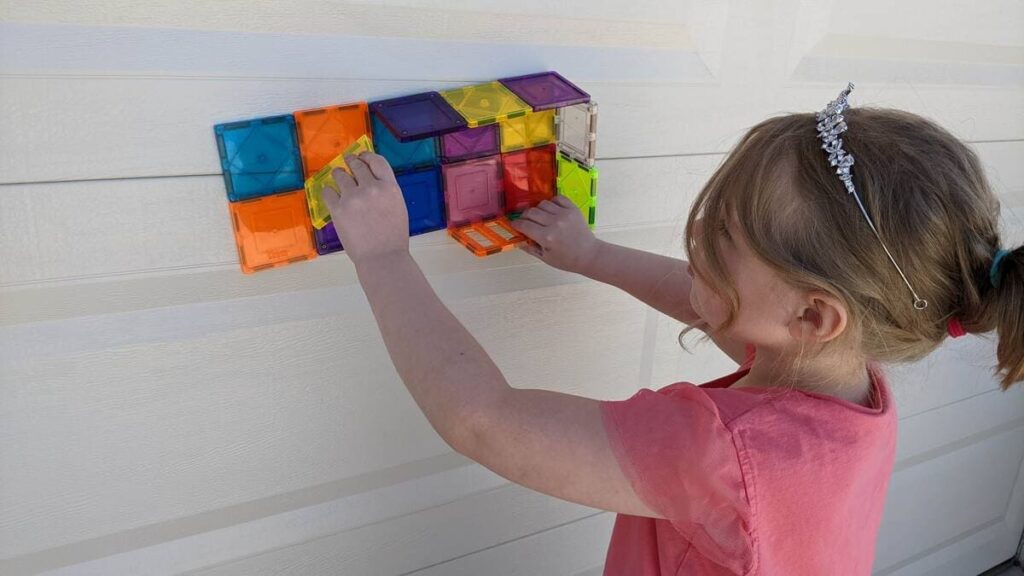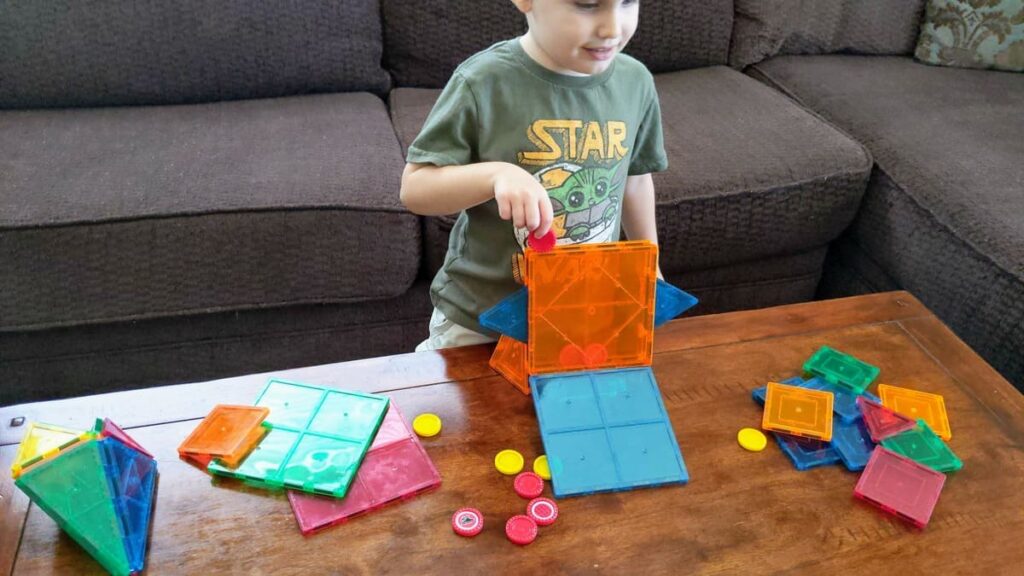When it comes to magnetic tiles vs traditional blocks, they have a lot in common. They get the creative juices flowing while seemingly just playing a game. Building a structure, figuring out problems, and getting satisfaction when you get something right that works.
This play is what keeps kids coming back over and over again. Building with magnetics or blocks is classic, clean fun that we should encourage our kids to play with.
Table of Contents
A Brief History of Play and Learning
Humans love to play. Psychologists like Peter Gray have written extensively about the role of play in human development, and anthropologists have found evidence of toys dating back to 2600 BCE. Play is one of the most foundational methods for learning and living.
The scope and methods of play have changed a bit since 2600 BCE, as anyone with video games will already know.
Certain games and toys, however, have stayed with us for an impressively long time.
Building blocks are one such invention.
Largely credited to Freidrich Fröbel, the creator of the kindergarten, building bricks or building blocks have always had an explicit role in learning environments for children. As their commodification grew, these toys have taken on new shapes and features, from interlocking bricks to animal-shaped blocks, to magnets.
With the wide variety of building toys available today, parents and educators may find it useful to compare and contrast some of these choices.
Let’s take a critical look at two essential building toys: traditional blocks and magnetic tiles.
Are you looking for magnetic titles but don’t know which brand to get? Take a look at my comparison of the two most popular brands: Magna Tiles vs Picasso Tiles.
Benefits of Traditional Blocks

Wooden blocks have been around for literal centuries, which is a true testament to their usefulness, versatility, and the joy they bring to children. Some benefits of wooden building blocks for kids include:
Natural Materials
While blocks may be made from different substrates, the majority are wood. Parents can find natural wooden blocks, or options that use dyes or non-toxic paints.
You can even find sets made from tree pieces, or consider carving your own.
Wide Range of Shapes
Blocks have become increasingly complex over the years, and now include shapes like arches, cylinders, and even balancing stones, which you won’t find in magnetic tiles.
Diverse Sets
Again, since these building toys have been around for a while, makers are branching out. These days, you can find a huge variety of wooden block-based play sets, including castles, cities, and trees. Magnetic tiles are just beginning to catch up.
Ease of Placement
Okay, this one is controversial, and you will find proponents in both the magnetic tile and the traditional block camp who believe their toy is easier for small hands to place.
Some blocks may be small, and they may require careful movements and attention to balance. However, this depends greatly on the application and the size and shape of the block.
For my part, I really struggle with magnetic tiles being drawn to unintended partners and collapsing. It happens right?
Open-Ended Play
Parents, kids, and experts agree, traditional blocks offer the most open-ended design, build, and play options. These are an incredibly versatile toy that supports creativity and divergent thinking even while sharpening specific STEM skills.
Lessons in Gravity
In the absence of magnets, builders are able to learn valuable lessons about gravity and related properties, like mass.
Some educators say this allows children to practice emotional and coping skills as their towers tumble to the ground, which is likely true. However, I would argue that magnetic tiles might offer the same practice (see my above commentary about magnetic structures collapsing).
Traditional blocks are beloved classics with plenty to offer. Even if you also opt to add magnetic tiles to your repertoire, standard blocks are a must-have for a great STEM/learning toy collection.
Benefits of Magnetic Tiles

Newer to the scene, magnetic tiles differ from traditional blocks in form and function. Here are a few key features of these colorful construction toys.
Lighter Weight
Magnetic tiles are typically lighter than wooden blocks, thanks to the properties of plastics. They are also flatter and will usually store more easily. This can be an important space-saving consideration in some homes.
Use on a Range of Surfaces
Thanks to the magnets, these building tools can move beyond the floor, table, or other horizontal surfaces. Many young builders enjoy sticking their magnetic tiles to metal cabinets, refrigerators, and other vertical structures — that’s something wooden blocks just won’t do.
Color Mixing
Magnetic tiles sometimes put the A in STEAM, as they can be more easily used to craft flat designs and pictures.
As most are transparent or semi-transparent, they also allow learners to explore color mixing. Exploring arts and sciences together is a wonderful win for child development.
If you have a little one make sure to see our article: Best Magna Tiles for Toddlers!
Safety
Most current and former public school teachers can recall a time when wooden blocks were thrown across a classroom or play space. Due to their size, weight, and shape, traditional blocks are more easily weaponized.
These lightweight alternatives, which come in sizes too large to present any choking risk, can be a safer option.
Lessons in Magnetism

While traditional block users will learn more about gravity, magnetic tile users will learn more about, well, magnets!
This is another interesting and useful physics concept to explore, and I think it makes magnetic tiles a great complement to traditional blocks.
For all of their similarities and differences, a building toy collection that includes both traditional blocks and magnetic tiles allows creative and curious young minds to thoroughly explore and compare STEM concepts.
Building Toys, STEM Principles, and Cognition
No matter what toys or objects you compile, allowing young people to build is a brain-boosting move. Kids organically learn science and math concepts such as geometry, symmetry, measurement, and basic physics through building.
At the same time, construction toys and tools also boost cognitive skills. Using blocks and tiles, learners develop persistence, concentration, organization, creative thinking skills, and frustration tolerance.
All of these things will support them throughout their lives, through childhood and beyond.
Wrapping Up
Humans, like other animals, are designed to learn through play. Building toys allow us to explore and understand a range of concepts, from the academic to the social-emotional. These time-tested learning tools have changed and improved with advancing technology, and their modern roles are both similar and different.
At the end of the day, the type of building toys that you choose for your child depends greatly on whatever is most appealing to them. It’s always good to include your children in decisions about learning and play. The toy that gets used the most is the most useful.









